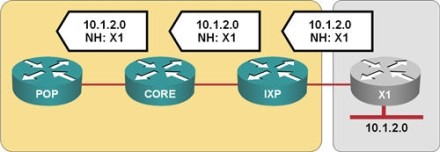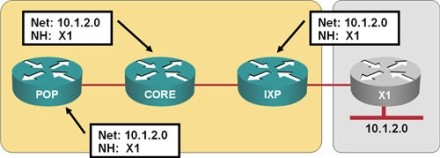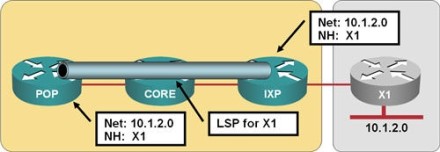If you want to deploy Border Gateway Protocol (BGP) throughout your network you have to run it on all core routers (and there are a number of reasons why you should) or at least that was the traditional wisdom.
With the introduction of MPLS you can run BGP only on the network's edges reducing the memory requirements and CPU load on your core routers while at the same time making them more stable.
To understand why MPLS technology has such an impact on your network let's review the basic facts of BGP routing. When BGP advertises a route between routers in the same network -- the same Autonomous System (AS) the next-hop of the route remains an IP address outside of the AS as shown in the diagram below.
Note: Most other routing protocols make the next hop of the route the IP address of the adjacent router.

Consequently when the routing tables are built on the routers in your autonomous system all entries for IP prefix 10.1.2.0 point to the same next hop: the IP address of the X1 router (see diagram below).

If a Label Switch Path (LSP) were established between the routers' POP and Internet Exchange Point (IXP) for the IP destination X1 the packets toward the network 10.1.2.0 would travel across the network encapsulated in MPLS headers and the core router would not need to have the BGP route toward the destination network (see diagram below).

The LSPs for all non-BGP destinations are built automatically once you enable MPLS with Label Distribution Protocol (LDP) in your network (unless you've configured LDP filters). The LSP between the POP and the IXP router is thus created automatically and the POP router starts using it to send packets toward the IP network 10.1.2.0 as soon as it's created. BGP is thus no longer needed on the core router as it never receives a non-MPLS-encapsulated IP packet for the network 10.1.2.0.
Once you decide to rely on MPLS to provide the edge-to-edge transport across you network core however BGP has to be deployed on all edge routers (similar to the MPLS VPN designs). You can no longer use default routing toward an IXP or toward your network core as your core routers cannot forward IP packets toward Internet destinations anymore. If you would like to retain default routing on the low-end access routers you could use the following design:
- The core routers run only MPLS and core IGP. These routers should never have to forward non-labeled IP packets toward external destinations. The only IP traffic they should handle is the routing protocol updates and network management queries.
- The distribution layer routers run BGP and provide end-to-end transport across label switched paths established in the network core.
- The distribution layer routers advertise default route toward those access routers that do not run BGP.
- Access routers might have full BGP routing table (needed for multi-homed customer) partial BGP routing table (for example only the routes toward your customers) or no BGP at all (in which case they would use the default route toward the closes distribution layer router for most of the traffic).
This design is very similar to IP-over-ATM designs used in early high-speed Internet backbones (when ATM was the only high-speed technology available). The only difference is in the backbone infrastructure where ATM switches have been replaced with routers significantly reducing per-port and per-switched-Gbps costs.
